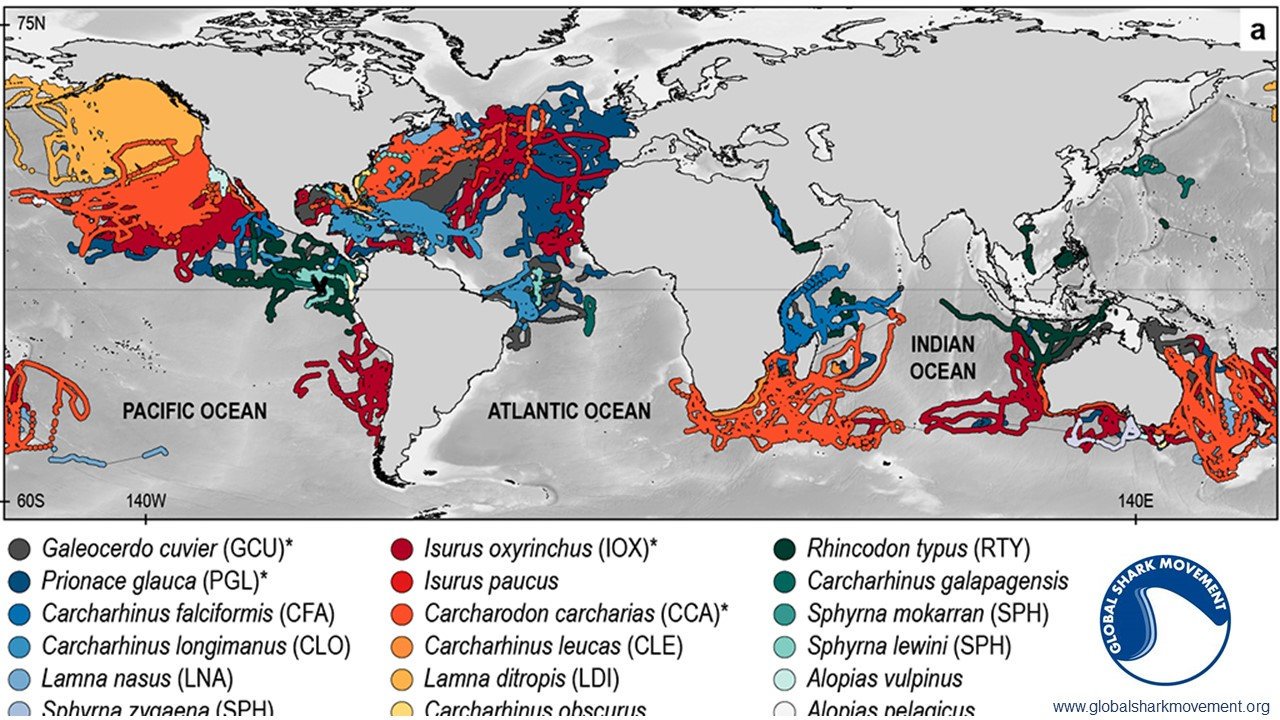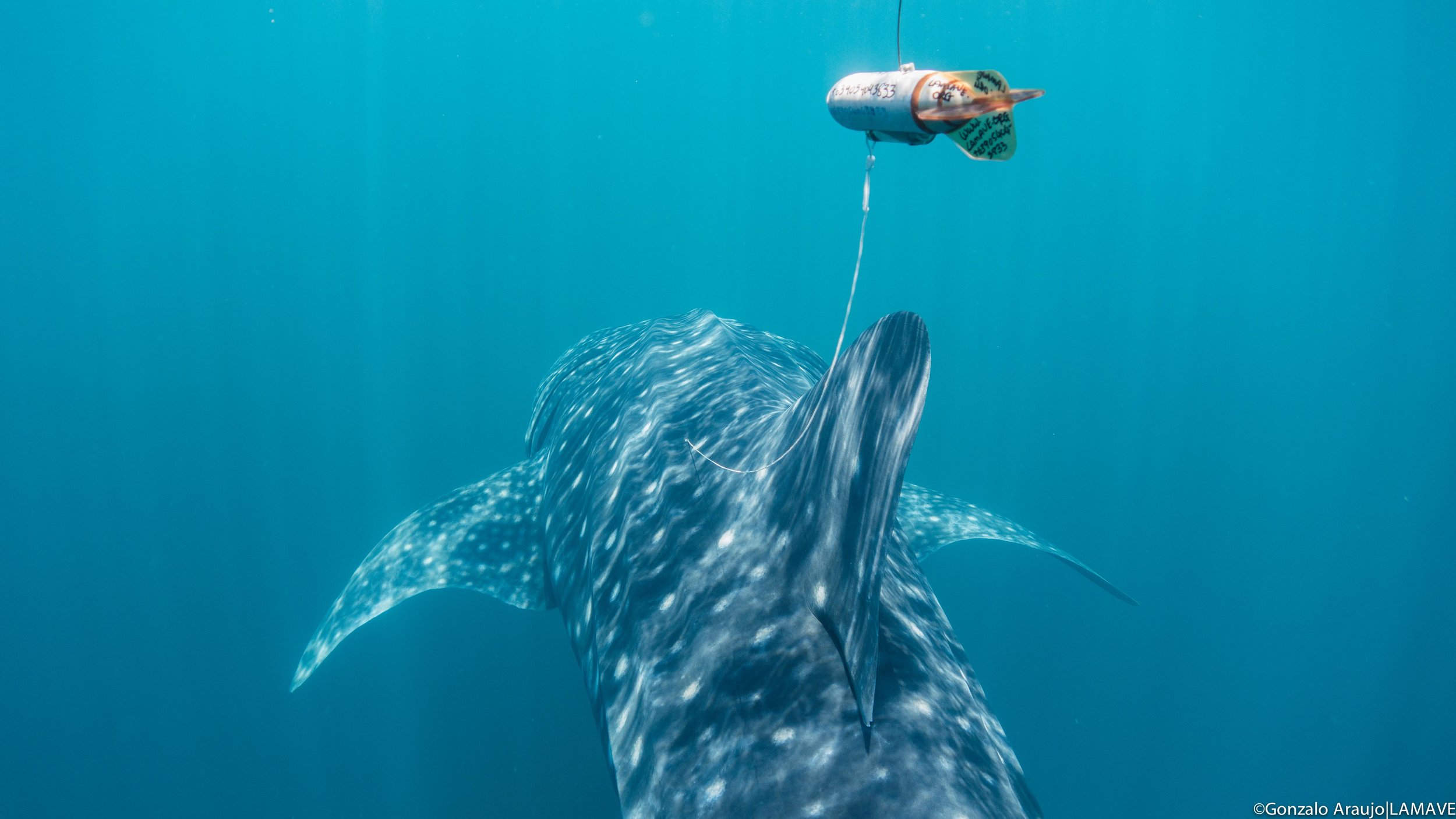NEWS
Ecology: Sharks under threat from fisheries
A new study published in Nature, International Journal of Science revealed that around one quarter of the habitats of oceanic sharks fall within active fishing zones, which may threaten these iconic ocean predators. The study spearheaded by David Sims and colleagues, brought together 1500+ satellite tracks globally from 150 scientists, including LAMAVE, and demonstrates an urgent need for conservation efforts to protect pelagic sharks, which reported to be in decline.
Pelagic (or oceanic) sharks are highly migratory, covering vast areas of the ocean—including areas targeted by fisheries. Large pelagic sharks account for around half of all identified shark catches from fisheries. The extent of habitat overlap with industrial fisheries has been difficult to determine, as data from fisheries about catch numbers can be incomplete.
By combining satellite-tracked movements of pelagic sharks and global fishing fleets, David Sims and colleagues provide a global estimate of space-use overlap. A total of 1,681 large pelagic sharks (23 species) tagged with satellite transmitters were followed, and fishing vessel movements were monitored by a safety and anti-collision system. Their results reveal that 24% of the space used by sharks in an average month falls under the footprint of pelagic longline fisheries, which are responsible for catching most sharks from the open ocean. Areas of ocean that are frequented by protected species, such as great white sharks and porbeagle sharks, had higher overlap with longline fleets (around 64%).
Satellite tracks from whale sharks tagged by LAMAVE and the Marine Megafauna Foundation (MMF) where included in the study. One limitation in SouthEast Asia is many fishing vessels do not possess an Automatic Identification System (AIS), which is a problem in terms of large scale monitoring of fisheries and shark interactions. The pressure may appear low in SouthEast Asia, but in reality this is largely due to the small uptake of AIS on vessels. In reality the overlap with sharks would be much larger.
These findings indicate that pelagic sharks have limited places in which they can take refuge from fisheries. The authors suggest that conservation efforts are needed to protect these sharks, and that designated large-scale marine protected areas around regions of shark activity could be one solution.
Adapted from a Press Release by David Sims.
For further information please contact: David Sims (Marine Biological Association of the United Kingdom, Plymouth, UK), dws[@]mba.ac.uk Tel: +44 (0)1752 426487

Tracks of different shark species.

A whale shark fitted with a satellite tag by LAMAVE and MMF.
Titus Espedido Cañete selected as one of 15 recipients of the National Geographic 2025 Wayfinder Award presented by Kia.
The National Geographic Society announced on June 5 2025 the 15 recipients of its 2025 Wayfinder Award presented by Kia, which included LAMAVE Project Lead Titus Canete. The award celebrates Explorers ‘transforming how we understand nature, culture and the future of the planet.’
LAMAVE LAUNCHES IMPACT MEDIA CAMPAIGN WITH FIRST DOCUMENTARY SCREENING AT PALAWAN STATE UNIVERSITY
University students and faculty members were among the audience of the first screening of “IYO ANG DAGAT” (The Sea is Yours), a documentary film that looks at the relationship between people and sharks in Palawan, Philippines.
Two Brothers, One Mission: Protecting Whale Sharks in Pintuyan, Southern Leyte
Ery and Raul Cordova, brothers who grew up along the coast of Pintuyan, Southern Leyte, have spent over a decade working with and protecting the whale sharks that frequent their local waters. Having spent their entire lives by the ocean—near one of the largest whale shark aggregation sites in the Philippines—the brothers grew up alongside the world's largest shark. They found their passion for conservation, inspired by the awe-inspiring presence of these gentle giants.
Empowering Tomorrow’s Marine Conservationists: Stories of Resilience and Hope
The ocean nourishes us all. Its value encompasses all facets of life, from the food we eat to the livelihood of communities, and the chance to collaborate with different cultures to ensure its protection. Yet today, the ocean needs protectors more than ever, and at the forefront of this mission are motivated individuals like Fatima Clavecillas and Paolo Co, scholars of LAMAVE’s Iskolar ng Dagat program. Their journeys demonstrate how opportunity and determination can turn passion into action and dreams into change.
A decade of LAMAVE research shapes IUCN Important Shark and Ray Areas in the Philippines
PUERTO PRINCESA CITY—Ten years of research by the Large Marine Vertebrates Research Institute Philippines (LAMAVE) has supported the delineation of six of the eleven “Important Shark and Ray Areas” (ISRA) identified in the Philippines as part of global efforts to map out critical habitats for sharks, rays, and chimaeras around the world.
Next phase of Global FinPrint seeks to improve protection of reef sharks worldwide
SARASOTA – Dec. 6, 2023 – With reef shark populations in crisis, Mote Marine Laboratory & Aquarium and partners from across the globe are updating the seminal shark survey, Global FinPrint, and applying their findings to the design of new marine protected areas (MPAs).
What is it like being a LAMAVE volunteer?
Volunteering overseas and making an impact in the conservation of marine wildlife is one of the most fulfilling experiences anyone can have. Charlotte Joliffe shares her most memorable moments as a volunteer in the Philippines for the Whale Shark Research & Conservation Project and how her experience has geared her to thrive in her marine sciences career.
Celebrating arts and music for the ocean this Fete de la Music
With the theme Mersea — a play on the French mer (sea) and merci (thank you) — LAMAVE has been chosen as the conservation beneficiary for this year's Fete de la Music celebration.
Into the Deep Sea with Titus Cañete
In celebration of Ocean Exploration Day, we sat down with LAMAVE researcher Titus Cañete to discuss what inspires him to study this mysterious zone and the technology he is developing that could help make deep sea research more accessible to early-career scientists.
The winners of the Tommy Schultz Travel and Adventure Photography contest are….
From over 165 entries sent in from all over the globe, our esteemed panel of judges have chosen the following winners for each category.
Collaborative research puts mantas on the map in the Philippines
PUERTO PRINCESA CITY— a new collaborative scientific study led by the Large Marine Vertebrates Research Institute Philippines (LAMAVE) and in cooperation with partners and the public has compiled a national population database for manta rays and has identified four hotspots for the species in the Philippines.
LAMAVE is launching the Northwestern Palawan Turtle Nesting Project in November 2022
The Turtle Nesting Project will initially focus on the municipalities in the northwest of Palawan, with the main base being in San Vicente. LAMAVE is supporting and amplifying the impact and work of the local POs and stakeholders, bringing people together, providing technical knowledge and expertise and providing opportunities for enhancing local capacity and professionalizing local teams and eco-tourism guides.
Calling all creatives and conservationists! LAMAVE launches a new fellowship program and a photography prize
PUERTO PRINCESA CITY— LAMAVE a marine conservation NGO, today announces the launch of a new initiative designed to support young Filipinos advocating for environmental conservation through impact media.
Hiraya launches 'Higanteng Pagi Journal' for conservation
Hiraya Journal showcases the beautiful manta rays of the Philippines in their latest design, the “Higanteng Pagi”. They are also supporting conservation efforts for these majestic giants by donating a portion of each sale to LAMAVE.
Studying Whale Sharks in the Philippines with LAMAVE as an Ocean Giants Programme Scholar
Early-career scientists can gain valuable experience in marine conservation and grow their network through on-site placements with NGOs like LAMAVE. Ocean Giants Programme scholar Robin Gould tells us about his experience during his placement with our Palawan Whale Shark Research and Conservation project in the Philippines.
The Typhoon and the Seaweed Farmers
In December 2021, we launched a fundraiser asking you to support communities affected by Typhoon Odette including seaweed farmers in the remote island municipality of Cagayancillo, Palawan, Philippines. You responded and together we raised ~795,000PHP (~USD$15,000). In February of this year our team travelled to Cagayancillo to carry out the on-the-ground efforts. LAMAVE Director Sally Snow, shares an insight into the journey…
LAMAVE and the National Geographic Society embarks on a Deep-Sea Expedition to the Tubbataha Reefs Natural Park in May 2022
This expedition aims to understand one of the most mysterious ecosystems in the planet — marine areas with depths greater than 200 meters. The team will deploy the first deep-sea camera system in the region!
Filipino sustainable fashion brand Astella launches marine-themed line in support of LAMAVE.
Astella is launching their new collection, "LAMAVE x Astella", on April 29 at 7 PM. This collection is a marine-themed, hand-printed line of apparel perfect for the Philippines' year-round summer! A portion of the sales from this collection will go to LAMAVE to support scientific research for the conservation of marine megafauna in the Philippines.
Expedition Shark 6 is Coming your Way!
Experience the best diving that the Philippines has to offer while making an impact in marine conservation. Get this rare opportunity to be on the frontline of conservation alongside experts from LAMAVE studying one of the last shark havens in Southeast Asia. Join us for a 9-day expedition to the heart of the Tubbataha Reefs Natural Park this June 7 to 15, 2022!
Good Luck Sue!
This year we say farewell to LAMAVE researcher Sue Ong as she sets out on new adventures. Sue has been part of the team since 2016 and made quite an impact during her time with us….
Make My Day, Watch Me Ray Ray
LAMAVE will soon launch the Everyday Hero Manta Ray Adoption Program, allowing environmentally-conscious people to make a tangible conservation impact. Read more and be the first to know when the Manta Ray Adoption Program opens.
LAMAVE as one of the mentors for the National Geographic Society 2022 STEM Field Assistant Program
We are super excited and honoured to have been chosen to partner with the National Geographic Society for its latest initiative, the STEM Field Assistant Program, and work together to inspire the ocean conservation leaders of tomorrow.
Humans of #TyphoonOdette - Jacky & Virginia Cuevas
“My grandkid told me “grandma, let’s leave now”, worried the strong winds would destroy the house. So we evacuated that very night… We didn’t wait too long to clean up whatever’s left of my house because it was everywhere. But we were only able to retrieve pillows, some blankets, and a few clothes.”…
Wrapping up 2021, a year of change, challenges and impact!
2020 may have been the year the world changed but 2021 is the year we changed. Along with the rest of the world, our team was continuously tested and we had to adapt to new ways of operating as we navigated one of the worlds longest COVID-19 lockdowns. Despite the roadblocks, we found a way forward, something we could not have done without the dedication of our team, partners and supporters. Now, as the year draws to a close we take a look back on some of the things we achieved this year.
Humans of Typhoon Odette - Andy Leonor
“We lost our livelihoods again because of Super Typhoon Odette. Nawalan kami ng hanapbuhay dahil kay Odette. I used to work in tourism here in Puerto Princesa but my job was affected by the pandemic. I looked for an alternative source to be able to survive, but then the typhoon came. It has been really difficult. I don’t know what to do anymore. So na Nahihirapan na ako. Hindi ko na alam kung anong gagawin ko. I don’t know how to start over.”
URGENT: Typhoon Odette Relief Fundraiser
We need your support NOW. The #Philippines is in a state of calamity after Super #TyphoonOdette (Rai). Entire communities have lost homes and livelihoods. Infrastructure and transportation links are devastated. Some have lost family members and many are at risk of losing lives as the situation deteriorates.
All LAMAVE team members are safe after #TyphoonOdette (Rai).
The team in Puerto Princesa City Palawan have just received access to communications through SMART (Wed 22 Dec)…
Kitakits Gonzo
The last two years brought about many changes at LAMAVE but one significant one was the departure of Gonzalo Araujo who stepped down from his role with LAMAVE in October 2020. Gonzo first joined the LAMAVE team in 2012, initially as a Project Leader for LAMAVE’s Cebu whale shark research project before becoming more invested in the leadership of the NGO.
Experience True Exploration - LAMAVE Partners with the Philippine Siren
LAMAVE and the elegant Philippine Siren team up once again to bring divers right to the heart of conservation and exploration.






























XDEEP welcomes LAMAVE into their Exploration Support Program
Diving is a crucial part of LAMAVE’s research to conserve endangered species: from deploying remote underwater video systems (RUVS) and maintaining our nationwide acoustic telemetry network to monitor shark and ray populations, to visual surveys during research expeditions….XDEEP supports marine conservation in the Philippines by adding LAMAVE to their Exploration Support Program, gearing our team with their state-of-the-art BCD lines — the NX Series Harness and NX Series Ultralight Harness.